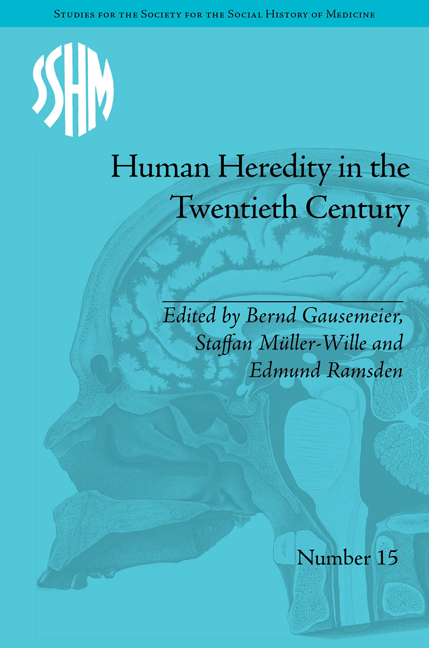Book contents
- Frontmatter
- Contents
- Acknowledgements
- List of Contributors
- List of Figures and Tables
- Introduction: Human Heredity in the Twentieth Century
- Part I Constructing Surveys of Heredity
- Part II Blood and Populations
- 4 From ‘Races’ to ‘Isolates’ and ‘Endogamous Communities’: Human Genetics and the Notion of Human Diversity in the 1950s
- 5 Between the Transfusion Services and Blood Group Research: Human Genetics in Britain during World War II
- 6 The Abandonment of Race: Researching Human Diversity in Switzerland, 1944–56
- 7 Post-War and Post-Revolution: Medical Genetics and Social Anthropology in Mexico, 1945–70
- Part III Human Heredity in the Laboratory
- Part IV Understanding and Managing Disease
- Part V Reconstructing Discipline(s)
- Notes
- Index
4 - From ‘Races’ to ‘Isolates’ and ‘Endogamous Communities’: Human Genetics and the Notion of Human Diversity in the 1950s
from Part II - Blood and Populations
- Frontmatter
- Contents
- Acknowledgements
- List of Contributors
- List of Figures and Tables
- Introduction: Human Heredity in the Twentieth Century
- Part I Constructing Surveys of Heredity
- Part II Blood and Populations
- 4 From ‘Races’ to ‘Isolates’ and ‘Endogamous Communities’: Human Genetics and the Notion of Human Diversity in the 1950s
- 5 Between the Transfusion Services and Blood Group Research: Human Genetics in Britain during World War II
- 6 The Abandonment of Race: Researching Human Diversity in Switzerland, 1944–56
- 7 Post-War and Post-Revolution: Medical Genetics and Social Anthropology in Mexico, 1945–70
- Part III Human Heredity in the Laboratory
- Part IV Understanding and Managing Disease
- Part V Reconstructing Discipline(s)
- Notes
- Index
Summary
For good reason, research into the history of human genetics has concentrated on medical genetics, eugenics and radiation genetics. The entanglement of research into heritable pathologies with discriminatory political and social practices has rendered human genetics a deeply problematic scientific field. Thus, when addressing the post-war era, historians have focused on the repercussions and continuities of human geneticists' interest in pathological conditions. By the same token, however, human geneticists' interest in the inheritance and variation of normal traits has largely been neglected.
To be sure, the community of human geneticists cannot easily be divided up into medical geneticists on the one hand and population geneticists on the other. Often, one and the same research team investigated both pathological conditions and normal traits within a population (however defined). From one field site, it was possible to contribute to both medical genetics and population genetics. For those more interested in population genetics, it was necessary to draw on the help of already established health care systems, primarily to secure access to their test subjects.
Yet for some, the primary aim was to assess human genetic variation in general – what would become known as ‘human diversity’ – to make it epistemologically productive for the investigation of genetic characters and to establish the evolutionary history of mankind.
- Type
- Chapter
- Information
- Human Heredity in the Twentieth Century , pp. 55 - 68Publisher: Pickering & ChattoFirst published in: 2014



